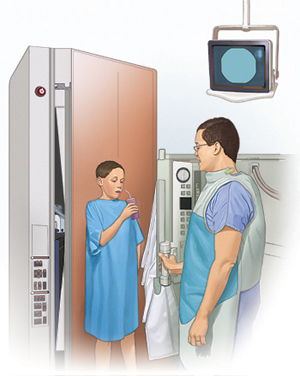When Your Child Needs an Upper Gastrointestinal (GI) Series
When Your Child Needs an Upper Gastrointestinal (GI) Series
An upper gastrointestinal (GI) series is an X-ray exam of the upper digestive tract. This includes the mouth, esophagus, stomach, and duodenum (first part of the small intestine). The exam is used to find problems such as strictures (narrowing), or ulcers (sores in the lining of the GI tract). Barium contrast or another kind of contrast material is used during the exam. This is a liquid that makes organs show more clearly on X-rays. During an upper GI series with small bowel follow-through, the healthcare provider also checks the small intestine. An upper GI series takes about 60 minutes. An upper GI series with small bowel follow-through takes about 3 hours.
Before the exam
Don’t give your child anything to eat or drink 4 to 6 hours before the exam. Newborns and infants may be allowed to drink up to 2 to 4 hours before the exam. Ask your child's healthcare provider for instructions.
Follow all other instructions given by the healthcare provider.
Let the technologist know
For your child’s safety, let the technologist know if your child:
|
|
During the exam
An upper GI series is performed by a radiologist. This is a doctor trained to use X-rays for treatment or diagnosis. A radiology technologist may also assist with the exam.
You can stay with your child in the X-ray room. You’ll be given a lead apron to wear for your safety. Pregnant women aren’t allowed in the X-ray room.
Your child stands against the X-ray table during the first part of the exam. After barium contrast is given, your child then lies down. Infants or toddlers lie down during the entire exam.
An X-ray of your child’s upper GI tract is taken.
Then your child is given barium contrast to drink. The barium may come in different flavors for a more pleasant taste. Infants may drink the barium from a baby bottle. Toddlers may drink it from a sippy cup. If your child can’t drink the barium, a nasogastric (NG) tube is used. This is a soft, flexible tube that’s inserted through your child’s nose into the stomach to send barium down the upper GI tract.
Movement affects the quality of the results. If your child can’t stay still, he or she may be gently held down.
Your child may also be given fizzy crystals to swallow. These make air build up in the stomach. Your child must resist the urge to burp or vomit, or more fizzy crystals or barium must be taken.
Live X-ray images (fluoroscopy) are viewed on a screen as the barium moves through your child’s upper GI tract.
Your child may need to roll over, shift positions, or take deep breaths and hold them while X-rays are taken.
After the exam
There’s a short wait while the X-rays are reviewed. More X-rays will need to be taken if results are unclear.
Unless told not to, your child can return to his or her normal routine and diet right away. But make sure your child drinks plenty of water. Water helps relieve constipation that may occur after the exam.
Your child’s stool appears chalky white or light for 1 to 2 days due to the barium in the contrast. If no barium is passed within 24 hours, call the healthcare provider.
The radiologist may discuss early results with you after the exam. A report is given to your child’s healthcare provider, who follows up with complete results.
Helping your child prepare
You can help your child by preparing him or her in advance. How you do this depends on your child’s needs.
Explain that the radiologist is checking for problems in the upper GI tract. Use brief and simple terms to describe the exam. Younger children have shorter attention spans, so do this shortly before the exam. Older children can be given more time to understand the exam in advance.
As best you can, describe how the exam will feel. Your child may not like the taste of the barium contrast. Your child may also feel full and need to pass gas.
Allow your child to ask questions.
Use play when helpful. This can involve role-playing with a child’s favorite toy or object. It may help older children to see pictures of what happens during the exam.
Possible risks and complications of an upper GI series
Radiation exposure from X-rays
Constipation or bowel obstruction due to retained barium
Allergic reaction (such as hives, itching, or wheezing) to barium
Updated:
August 16, 2018
Sources:
Upper GI Exam. Narins Brigham. The Gale Encyclopedia of Nursing and Allied Health. 2013;6(3):3425–3427., Upper GI Series. Longe Jacqueline. The Gale Encyclopedia of Cancer. 2010:2(3):1522–1524.
Reviewed By:
Freeborn, Donna, PhD, CNM, FNP,Lehrer, Jenifer, MD
